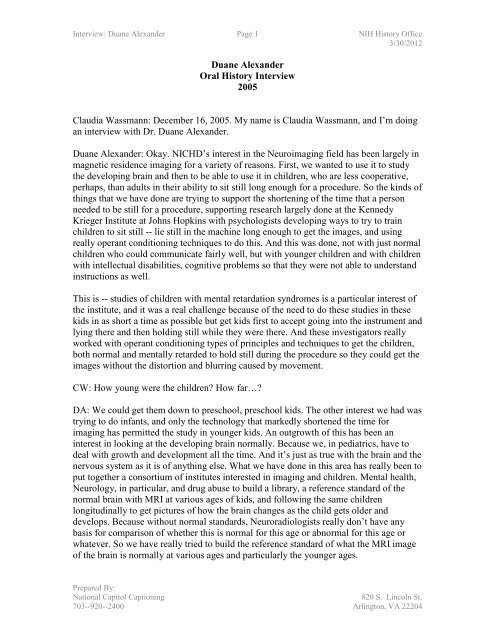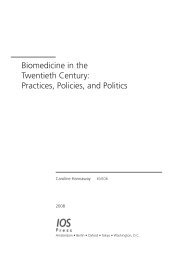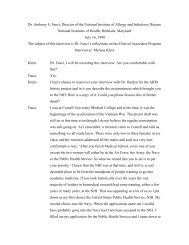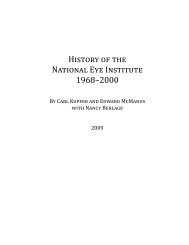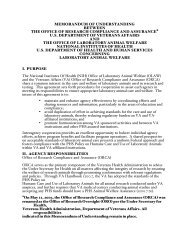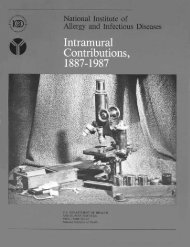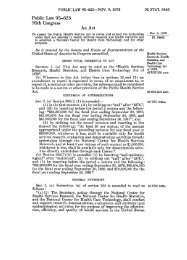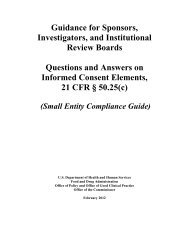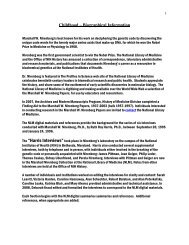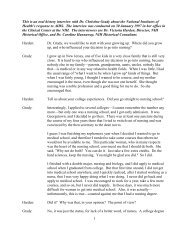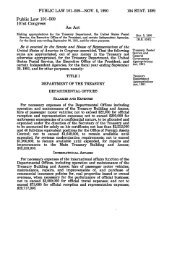Duane Alexander oral history - Office of NIH History
Duane Alexander oral history - Office of NIH History
Duane Alexander oral history - Office of NIH History
Create successful ePaper yourself
Turn your PDF publications into a flip-book with our unique Google optimized e-Paper software.
Interview: <strong>Duane</strong> <strong>Alexander</strong> Page 1 <strong>NIH</strong> <strong>History</strong> <strong>Office</strong>3/30/2012<strong>Duane</strong> <strong>Alexander</strong>Oral <strong>History</strong> Interview2005Claudia Wassmann: December 16, 2005. My name is Claudia Wassmann, and I’m doingan interview with Dr. <strong>Duane</strong> <strong>Alexander</strong>.<strong>Duane</strong> <strong>Alexander</strong>: Okay. NICHD’s interest in the Neuroimaging field has been largely inmagnetic residence imaging for a variety <strong>of</strong> reasons. First, we wanted to use it to studythe developing brain and then to be able to use it in children, who are less cooperative,perhaps, than adults in their ability to sit still long enough for a procedure. So the kinds <strong>of</strong>things that we have done are trying to support the shortening <strong>of</strong> the time that a personneeded to be still for a procedure, supporting research largely done at the KennedyKrieger Institute at Johns Hopkins with psychologists developing ways to try to trainchildren to sit still -- lie still in the machine long enough to get the images, and usingreally operant conditioning techniques to do this. And this was done, not with just normalchildren who could communicate fairly well, but with younger children and with childrenwith intellectual disabilities, cognitive problems so that they were not able to understandinstructions as well.This is -- studies <strong>of</strong> children with mental retardation syndromes is a particular interest <strong>of</strong>the institute, and it was a real challenge because <strong>of</strong> the need to do these studies in thesekids in as short a time as possible but get kids first to accept going into the instrument andlying there and then holding still while they were there. And these investigators reallyworked with operant conditioning types <strong>of</strong> principles and techniques to get the children,both normal and mentally retarded to hold still during the procedure so they could get theimages without the distortion and blurring caused by movement.CW: How young were the children? How far…?DA: We could get them down to preschool, preschool kids. The other interest we had wastrying to do infants, and only the technology that markedly shortened the time forimaging has permitted the study in younger kids. An outgrowth <strong>of</strong> this has been aninterest in looking at the developing brain normally. Because we, in pediatrics, have todeal with growth and development all the time. And it’s just as true with the brain and thenervous system as it is <strong>of</strong> anything else. What we have done in this area has really been toput together a consortium <strong>of</strong> institutes interested in imaging and children. Mental health,Neurology, in particular, and drug abuse to build a library, a reference standard <strong>of</strong> thenormal brain with MRI at various ages <strong>of</strong> kids, and following the same childrenlongitudinally to get pictures <strong>of</strong> how the brain changes as the child gets older anddevelops. Because without normal standards, Neuroradiologists really don’t have anybasis for comparison <strong>of</strong> whether this is normal for this age or abnormal for this age orwhatever. So we have really tried to build the reference standard <strong>of</strong> what the MRI image<strong>of</strong> the brain is normally at various ages and particularly the younger ages.Prepared By:National Capitol Captioning820 S. Lincoln St.703--920--2400 Arlington, VA 22204
Interview: <strong>Duane</strong> <strong>Alexander</strong> Page 2 <strong>NIH</strong> <strong>History</strong> <strong>Office</strong>3/30/2012So that’s been a project that’s been going on for several years now with excellentcooperation from -- and funding, co-funding from the institute participating in this.CW: So did you recall when it started, approximately?DA: That effort started about five years ago.CW: Five years ago, and is there someone I should talk to who was the initiator?DA: Yeah, Lisa Freund from our institute has been the main driver and leader from thatgroup from NICHD, and she has counterparts in the other institutes that have workedwith her. And the other thing that has evolved has been the functional MRI. And as thathas developed, we’ve also wished to try to get normative standards for FMRI for childrenat various ages and stages <strong>of</strong> development as well. So that’s a process that hopefullywe’re going to be able to build onto the just regular MRI standards and get standards forFMRI as well. The other thing that NICHD has contributed from its intramural programhas been diffusion tensor imaging. So our physical scientists in the intramural programhave helped to develop that whole new imaging technique. That <strong>of</strong>fers a major edge on towhat a regular MRI does. So hopefully this is starting to enter into wider use now, andwe’re probably going to have to do the same things in terms <strong>of</strong> building the database forthe normal standards for DTI that we’ve done for MRI.CW: Okay.DA: That’s it.CW: Thank you very much. That was wonderful.DA: Yeah, that’s just about all I know.CW: So at the moment that your institute got involved in imaging was pretty much in themid-‘90s or…?DA: Yeah, probably. Oh, let me say -- add another thing. One <strong>of</strong> very most valuable useswe’ve had with this has been with FMRI, when it came along, using it with kids withreading disability and other learning disabilities, showing how the brains <strong>of</strong> Children whoare normal except for reading disability differ from children who are normal and don’thave a reading disability. And how that pattern <strong>of</strong> F1 FMRI changes with appropriateinstruction for these kids who do have a disability and how it tends to change in someinstances toward a normal pattern, but in other instances toward a different abnormalpattern that bypasses the usual normal pattern but still allows these kids to develop thereading skill and to function. So that’s been very instructive as a means <strong>of</strong> studying thesekids with this particular learning disability. And we suspect that it will carry over intokids with other learning problems as well. But that’s been a major contribution <strong>of</strong> FMRIto our study <strong>of</strong> these kids with learning disabilities.Prepared By:National Capitol Captioning820 S. Lincoln St.703--920--2400 Arlington, VA 22204
Interview: <strong>Duane</strong> <strong>Alexander</strong> Page 3 <strong>NIH</strong> <strong>History</strong> <strong>Office</strong>3/30/2012CW: And who is the person I should talk to in regards to that?DA: From NICHD, probably Peggy McCardle in our Human Learning and Behaviorbranch or Child Development and Behavior branch. And she’s in the same branch withLisa Freud, whose name I gave you.CW: Okay, well, thank you very much.DA: Okay. That’s about all I have to contribute to this one.Prepared By:National Capitol Captioning820 S. Lincoln St.703--920--2400 Arlington, VA 22204


